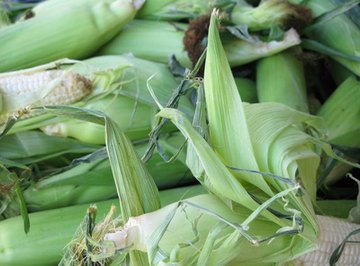
Weeds can reduce crop yield by competing for resources with crop plants. Reducing weeds on a large scale is best accomplished through the use of herbicides. Herbicides are a group of pesticides that control or eliminate the growth of weeds. Herbicides have many different modes of action, one of which is inhibiting photosynthesis -- a process vital to plant survival.
Types of Herbicides
Herbicides work to reduce weed pests through many mechanisms, but all serve to disrupt weed growth. Growth regulators diminish cell division and enlargement and are used largely to kill broadleaf weeds (i.e., primarily to protect grass crops such as corn), usually through the use of hormones. Pigment inhibitors break down chlorophyll (the pigment that gives plants their green color), which is necessary for photosynthesis to occur. Seedling growth inhibitors work by inhibiting plant growth just after germination, interfering with the growth of either roots or shoots (i.e., leaves). Other herbicides work by inhibiting the production of materials necessary for plant growth (e.g., amino acids or lipids).
What Is Photosynthesis?
Photosynthesis is the process by which plants use sunlight, carbon dioxide and water to make sugars (for enzymes and growth) and oxygen. The photosynthetic process is vital to life on earth, because it creates the oxygen animals, including humans, need for respiration. Biochemically speaking, photosynthesis is a fairly complicated process that takes place within plant cells and requires many enzymes and the transfer of electrons. If any of these photosynthetic systems is disrupted for any reason, the process will shut down and the plant will die. Photosynthesis, therefore, is the target of a group of herbicides known as photosynthetic inhibitors.
How Photosynthesis Inhibitors Work
Photosynthesis is driven largely by the transfer of electrons from chlorophyll molecules into the surrounding cytochromes. These electrons are passed along a series of cytochromes in what is known as an electron transport system. Sunlight activates these electrons where they are passed along another electron transport chain and are eventually used in a carbon-fixing reaction. Photosynthesis-inhibiting herbicides work by blocking the transfer of electrons. Without electron transfer, energy from the sun cannot be transformed into energy that is usable by plants to generate new tissue and sustain life.
Photosynthetic Inhibitor Uses
Inhibitors of photosynthesis are used mainly to control broad-leaved weed pests. That is, grass crops such as corn benefit the most from photosynthetic inhibitors.
Symptoms of Photosynthesis Inhibitors
Plants that have been exposed to photosynthesis-inhibiting herbicides will begin to appear yellow on the veins and around the edges of the oldest leaves, which will be followed by similar damage to younger leaves. Yellow spots may also appear on affected leaves.
